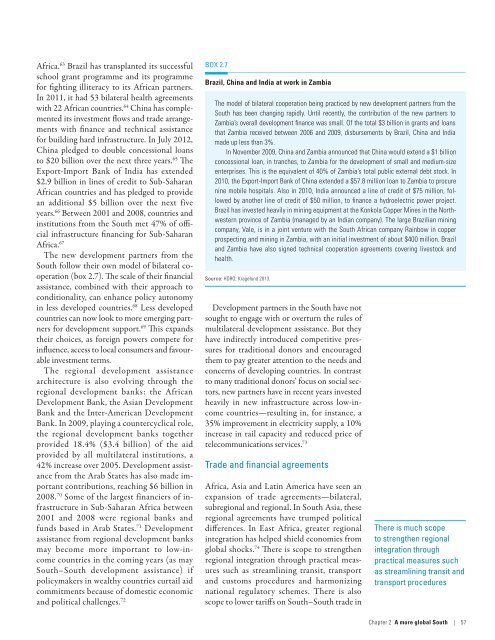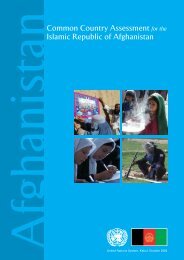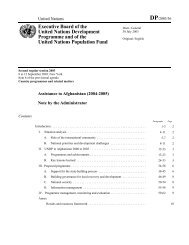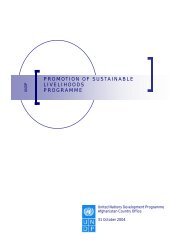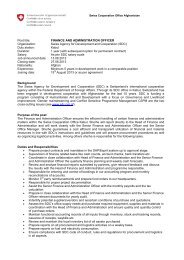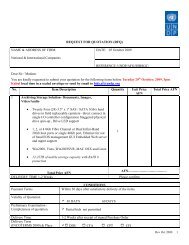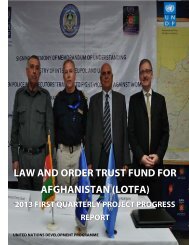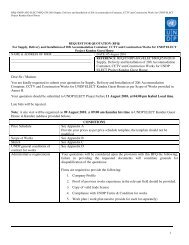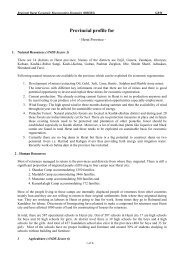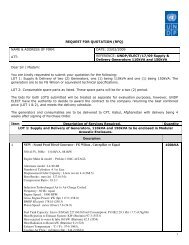E N S W - Human Development Reports - United Nations ...
E N S W - Human Development Reports - United Nations ...
E N S W - Human Development Reports - United Nations ...
You also want an ePaper? Increase the reach of your titles
YUMPU automatically turns print PDFs into web optimized ePapers that Google loves.
Africa. 63 Brazil has transplanted its successful<br />
school grant programme and its programme<br />
for fighting illiteracy to its African partners.<br />
In 2011, it had 53 bilateral health agreements<br />
with 22 African countries. 64 China has complemented<br />
its investment flows and trade arrangements<br />
with finance and technical assistance<br />
for building hard infrastructure. In July 2012,<br />
China pledged to double concessional loans<br />
to $20 billion over the next three years. 65 The<br />
Export-Import Bank of India has extended<br />
$2.9 billion in lines of credit to Sub-Saharan<br />
African countries and has pledged to provide<br />
an additional $5 billion over the next five<br />
years. 66 Between 2001 and 2008, countries and<br />
institutions from the South met 47% of official<br />
infrastructure financing for Sub-Saharan<br />
Africa. 67<br />
The new development partners from the<br />
South follow their own model of bilateral cooperation<br />
(box 2.7). The scale of their financial<br />
assistance, combined with their approach to<br />
conditionality, can enhance policy autonomy<br />
in less developed countries. 68 Less developed<br />
countries can now look to more emerging partners<br />
for development support. 69 This expands<br />
their choices, as foreign powers compete for<br />
influence, access to local consumers and favourable<br />
investment terms.<br />
The regional development assistance<br />
architecture is also evolving through the<br />
regional development banks: the African<br />
<strong>Development</strong> Bank, the Asian <strong>Development</strong><br />
Bank and the Inter-American <strong>Development</strong><br />
Bank. In 2009, playing a countercyclical role,<br />
the regional development banks together<br />
provided 18.4% ($3.4 billion) of the aid<br />
provided by all multilateral institutions, a<br />
42% increase over 2005. <strong>Development</strong> assistance<br />
from the Arab States has also made important<br />
contributions, reaching $6 billion in<br />
2008. 70 Some of the largest financiers of infrastructure<br />
in Sub-Saharan Africa between<br />
2001 and 2008 were regional banks and<br />
funds based in Arab States. 71 <strong>Development</strong><br />
assistance from regional development banks<br />
may become more important to low-income<br />
countries in the coming years (as may<br />
South–South development assistance) if<br />
policymakers in wealthy countries curtail aid<br />
commitments because of domestic economic<br />
and political challenges. 72<br />
BOX 2.7<br />
Brazil, China and India at work in Zambia<br />
The model of bilateral cooperation being practiced by new development partners from the<br />
South has been changing rapidly. Until recently, the contribution of the new partners to<br />
Zambia’s overall development finance was small. Of the total $3 billion in grants and loans<br />
that Zambia received between 2006 and 2009, disbursements by Brazil, China and India<br />
made up less than 3%.<br />
In November 2009, China and Zambia announced that China would extend a $1 billion<br />
concessional loan, in tranches, to Zambia for the development of small and medium-size<br />
enterprises. This is the equivalent of 40% of Zambia’s total public external debt stock. In<br />
2010, the Export-Import Bank of China extended a $57.8 million loan to Zambia to procure<br />
nine mobile hospitals. Also in 2010, India announced a line of credit of $75 million, followed<br />
by another line of credit of $50 million, to finance a hydroelectric power project.<br />
Brazil has invested heavily in mining equipment at the Konkola Copper Mines in the Northwestern<br />
province of Zambia (managed by an Indian company). The large Brazilian mining<br />
company, Vale, is in a joint venture with the South African company Rainbow in copper<br />
prospecting and mining in Zambia, with an initial investment of about $400 million. Brazil<br />
and Zambia have also signed technical cooperation agreements covering livestock and<br />
health.<br />
Source: HDRO; Kragelund 2013.<br />
<strong>Development</strong> partners in the South have not<br />
sought to engage with or overturn the rules of<br />
multilateral development assistance. But they<br />
have indirectly introduced competitive pressures<br />
for traditional donors and encouraged<br />
them to pay greater attention to the needs and<br />
concerns of developing countries. In contrast<br />
to many traditional donors’ focus on social sectors,<br />
new partners have in recent years invested<br />
heavily in new infrastructure across low-income<br />
countries—resulting in, for instance, a<br />
35% improvement in electricity supply, a 10%<br />
increase in rail capacity and reduced price of<br />
telecommunications services. 73<br />
Trade and financial agreements<br />
Africa, Asia and Latin America have seen an<br />
expansion of trade agreements—bilateral,<br />
subregional and regional. In South Asia, these<br />
regional agreements have trumped political<br />
differences. In East Africa, greater regional<br />
integration has helped shield economies from<br />
global shocks. 74 There is scope to strengthen<br />
regional integration through practical measures<br />
such as streamlining transit, transport<br />
and customs procedures and harmonizing<br />
national regulatory schemes. There is also<br />
scope to lower tariffs on South–South trade in<br />
There is much scope<br />
to strengthen regional<br />
integration through<br />
practical measures such<br />
as streamlining transit and<br />
transport procedures<br />
Chapter 2 A more global South | 57


